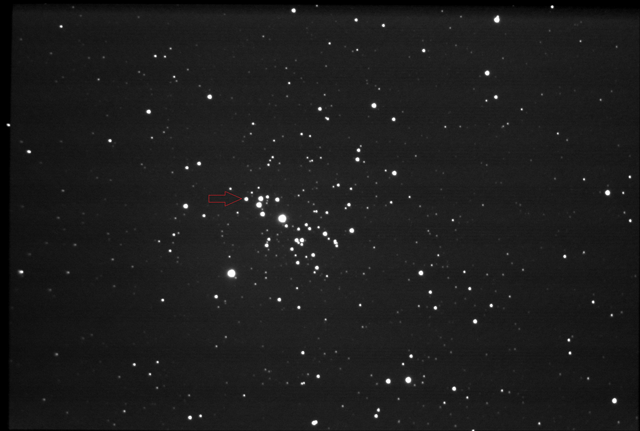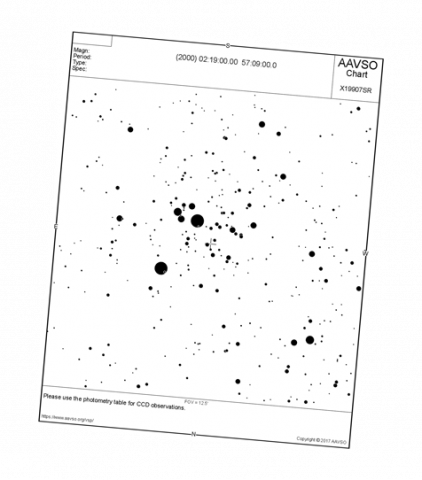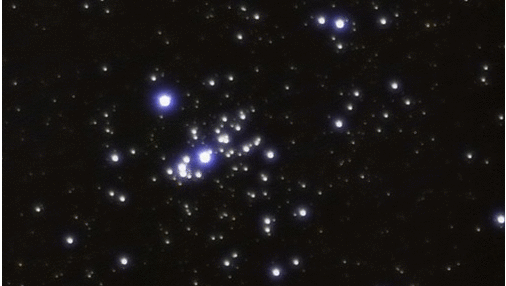- This topic has 10 replies, 6 voices, and was last updated 8 years, 5 months ago by
 David Swan.
David Swan.
-
AuthorPosts
-
29 July 2017 at 12:42 pm #573802
 David SwanParticipant
David SwanParticipantHello,
I am having trouble relating my deep sky images to star charts. If I compare my recent (stacked, perhaps this is important and some artefact has been introduced?) image of h Persei with an AAVSO output (limiting mag 15, FoV 12.5 arcmin) centred on the coordinates of the object, there is good but not precise agreement. I have highlighted an example of a relatively bright ‘star’ which is in the image, but not in the AAVSO plot.
Darks were applied, so I’m unclear as to what’s going on. There will no doubt be a simple explanation!
Thanks,
David
With thanks to the AAVSO for their variable star plotter tool.


Attachments:
29 July 2017 at 4:59 pm #578393 Dr Andrew SmithParticipant
Dr Andrew SmithParticipantAs James said I would think it a combination of non stellar objects, precession (chart is for 2000), proper motion, chart errors.
Regards Andrew
29 July 2017 at 5:10 pm #578394 David SwanParticipant
David SwanParticipantHello,
Yes, I’ve been looking at recent images taken by others that are publicly available – trying to find images at a similar scale is quite difficult! – and many of the ‘problem’ stars are in their images, so I’m more confident that there isn’t a major problem with my set-up. I’m planning to get more into deep sky imaging, hence the basic questions.
David
29 July 2017 at 5:10 pm #578392 DawsonParticipant
DawsonParticipantDavid,
I’ve made a quick animated GIF of the two images in your post (I’ve inverted the black and white in the AAVSO plot). There are lots of “differences”. I suspect some may be non-stellar objects. How accurate is the AAVSO chart, how are these charts constructed, and how old are they; might some also be proper motion of stars? Will be interesting to see what others say.
 29 July 2017 at 5:17 pm #578395
29 July 2017 at 5:17 pm #578395 Andy WilsonKeymaster
Andy WilsonKeymasterThere are a couple of other factors which will change how the chart looks.
First it will depend on which filter, filters or unfiltered were used when acquiring the image. I suspect the AAVSO chart is showing magnitudes for a V filter, so you would expect similar results when using a V filter on your camera. However, unfiltered or RGB would cause the stars to appear at different relative brightness. For example very red stars will typically appear much brighter in an unfiltered image.
The other factor is variable stars. You will occasionally come across other stars in your field which vary in magnitude by a sufficient degree to look different. Indeed great care has to be taken when producing charts for variable star measurement, to ensure that non of the comparison stars are themselves variable.
Nice image by the way 🙂
Best wishes,
Andy
29 July 2017 at 6:32 pm #578396 David SwanParticipant29 July 2017 at 7:45 pm #578398
David SwanParticipant29 July 2017 at 7:45 pm #578398 David SwanParticipant
David SwanParticipantThe link works. Thanks very much Jeremy – I had overlooked this option, which is very useful. And yes, the other stars are there. Great issue of the journal by the way. David
29 July 2017 at 7:49 pm #578399 Gary PoynerParticipant
Gary PoynerParticipantYes, very often the plotted star charts from AAVSO VSP miss out stars at all magnitude levels. Far better to plot a chart using the Digitised Sky Survey as Jeremy notes. It’s good for visual observers too, but you can’t set a magnitude limit for the stars of course, just the sequence.
Gary
29 July 2017 at 9:21 pm #578397 Jeremy ShearsParticipant
Jeremy ShearsParticipantHello David,
the AAVSO charts that are _plotted_ with dots for stars do have stars missing in some areas. But you can also request the Variable Star Plotter to send back a DSS _image_ of the field instead (there is a tick-box in the VSP set-up box for that). If you do that, the image does show your star I think. Here’s the link to a chart that shows the field (I hope it appears correctly in the post as it’s a very long address!):
All the best,
Jeremy
29 July 2017 at 11:31 pm #578402 DawsonParticipant
DawsonParticipantDavid,
Making another animated GIF of your original image with the astrobin image, I can’t see any vanishing stars this time:
 30 July 2017 at 7:29 am #578405
30 July 2017 at 7:29 am #578405 David SwanParticipant
David SwanParticipantCheers James: good image stretching. And thanks all.
Let’s hope August gives us good astro weather, with a large high pressure area stuck over the UK affording clear skies and still air. LOL. David
-
AuthorPosts
- You must be logged in to reply to this topic.
